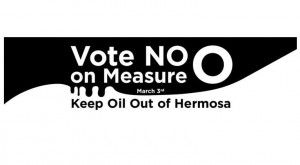Hermosa Beach oil drilling sunk by voters
 Drill, baby, drill?
Drill, baby, drill?
In Hermosa Beach on Tuesday, voters instead replied: No, baby, no.
On the wave of a big turnout, 79 percent of city voters rejected Measure O for “oil.” According to Ballotpedia, the measure would have authorized 34 new wells through “an oil drilling and production project agreement between the city and E&B Natural Resources Management Corporation, providing for an exemption to the city’s ban on oil and gas drilling.”
Though the politics of drilling turned the city vote into fodder for a familiar national controversy, the outcome hinged on a decades-old saga affecting the beach community. At the same time, clear ideological lines were blurred by the complicated scheme of subsidies promised to Hermosa Beach and its public schools.
A historic vote
Especially in recent years, the word “historic” has been used to describe outcomes or events that count toward some bigger sense of progress or social change. Although anti-drilling advocates made clear they viewed the Hermosa Beach vote that way, voters cast their ballots against the backdrop of a more traditional kind of history.
For years, long-running peculiarities defined their municipality’s hesitant approach to oil. As the LA Weekly recounted, Hermosa Beach has puzzled through the costs and benefits of drilling for generations.
A 1932 vote wiped out any oil and gas exploitation within city limits. Residents only loosened the ban in 1984, green lighting two initiatives that allowed drilling at two locations. One such permit went to Macpherson Oil.
By 1992, the City Council had signed off on a so-called slant drilling plan; Macpherson would access offshore oil by angling its bits and pipes from an onshore facility.
Three years after the slant drilling plan was approved, voters pulled the rug out from under Macpherson by reimposing their 1932-era ban on all drilling. Three years after that, in 1998, the City Council reversed itself completely and opted to scuttle Macpherson’s whole setup.
Perhaps predictably, Macpherson took the city to court. Perhaps even more predictably, the case never made it to trial.
A settlement blessed Macpherson’s sale of its Hermosa Beach stake to another firm, E&B Natural Resources, which secured, as part of the deal, an allowance to seek voter approval for its own take on the Macpherson plan.
Late last year, the Hermosa Beach City Council finally gave its approval to the wording of E&B’s ballot initiative — vowing to stay neutral and merely provide voters information in the run-up to this week’s referendum.
Shock waves
At once, friends and foes of offshore American drilling interpreted the long-gestating Hermosa Beach vote as a bellwether. Advocates on both sides sprung into action accordingly.
Up and down the L.A. coast, anti-drilling activists used the vote to warn that, if Hermosa Beach approved E&B’s plan, drilling would proliferate. The Santa Monica City Council could offer only token opposition, but did.
Manhattan Beach, the nearby Del Rey Neighborhood Council and the Surfrider Foundation followed suit. Heal the Bay, the National Resources Defense Council and others brought Robert F. Kennedy Jr. into town to decry the measure.
In an effort to woo voters, meanwhile, E&B worked to ensure that it helped subsidize popular local priorities. As the New York Times observed, the quirks of the agreement that teed up the vote put E&B in the strange position of punishing Hermosa Beach if residents voted against it. Opting against drilling triggered a payout of $17.5 million in damages to E&B, “the equivalent of about half the annual general fund budget in this city of almost 20,000 people.”
Currying favor, E&B touted the $600 million-odd windfall in royalties it said Hermosa Beach would enjoy if the deal went through.
Oil markets
But the exigencies of the oil markets, and the shifting sands of its increasingly complicated agreements, made the potential payout more uncertain. A cost-benefit analysis commissioned from Kosmont Companies by the City Council assumed oil would hover around $95 a barrel. But the plunging oil prices of recent months forced Kosmont to revise its analysis in a supplemental report designed to better sync estimates with market prices and future projections.
Reported EasyReaderNews.com:
“The school district would receive $1.8 million at $95 per barrel and $1.4 million at $40/per under the terms of the lease agreement, Kosmont said. The education foundation would receive $16.5 million at $95 per barrel and $7.1 million at $40 per barrel under the terms of the development agreement, Kosmont said.
“Should voters not lift the oil ban, Kosmont said, the city would need to repay E&B the $17.5 million loan. The city has $6 million set aside to meet this obligation. The balance, Kosmont said, would cost $825,000 to finance over 30 years. The city’s current annual budget is $34 million.”
Amid the flurry of numbers, Hermosa Beach residents found themselves increasingly divided, even bickering over the vote. The anxiety of drilling may now be over, but the costly payout now adds to the burden of taxpayers.
Related Articles
Elon Musk slams CA air board over credits for zero-emissions vehicles
Stiffed, as he sees it, by bureaucratic incompetence, Elon Musk took the California Air Resources Board to task for
Unions central to Brown’s infrastructure plans
Faced with a restive constituency disgruntled by drought, Gov. Jerry Brown has moved to execute on his plans for California




